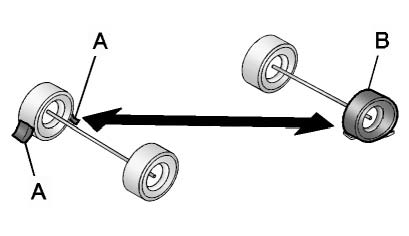 Buick Enclave: If a Tire Goes Flat
Buick Enclave: If a Tire Goes Flat
It is unusual for a tire to blow out, especially if the tires are maintained properly. See Tires .
If air goes out of a tire, it is much more likely to leak out slowly. But if there is ever a blowout, here are a few tips about what to expect and what to do:
If a front tire fails, the flat tire creates a drag that pulls the vehicle toward that side. Take your foot off the accelerator pedal and grip the steering wheel firmly. Steer to maintain lane position, and then gently brake to a stop, well off the road, if possible.
► rear blowout, particularly on a curve, acts much like a skid and may require the same correction as used in a skid. Stop pressing the accelerator pedal and steer to straighten the vehicle. It may be very bumpy and noisy. Gently brake to a stop, well off the road, if possible. WARNING
WARNING
Driving on a flat tire will cause permanent damage to the tire.
Re-inflating a tire after it has been driven on while severely underinflated or flat may cause a blowout and a serious crash.
Never attempt to re-inflate a tire that has been driven on while severely underinflated or flat.
Have your dealer or an authorized tire service center repair or replace the flat tire as soon as possible.
 WARNING
WARNING
Lifting a vehicle and getting under it to do maintenance or repairs is dangerous
without the appropriate safety equipment and training. If a jack is provided with
the vehicle, it is designed only for changing a flat tire. If it is used for anything
else, you or others could be badly injured or killed if the vehicle slips off the
jack. If a jack is provided with the vehicle, only use it for changing a flat tire.
If a tire goes flat, avoid further tire and wheel damage by driving slowly to a level place, well off the road, if possible. Turn on the hazard warning flashers. See Hazard Warning Flashers .
 WARNING
WARNING
Changing a tire can be dangerous. The vehicle can slip off the jack and roll
over or fall causing injury or death.
Find a level place to change the tire. To help prevent the vehicle from moving:
1. Set the parking brake firmly.
2. Put an automatic transmission in P (Park) or a manual transmission in 1 (First)
or R (Reverse).
3. Turn off the engine and do not restart while the vehicle is raised.
4. Do not allow passengers to remain in the vehicle.
5. Place wheel blocks on both sides of the tire at the opposite corner of the tire
being changed.
This vehicle may come with a jack and spare tire or a tire sealant and compressor kit. To use the jacking equipment to change a spare tire safely, follow the instructions below. Then see Tire Changing . To use the tire sealant and compressor kit, see Tire Sealant and Compressor Kit
When the vehicle has a flat tire (B), use the following example as a guide to assist you in the placement of wheel blocks (A).

A. Wheel Block
B. Flat Tire
The following information explains how to repair or change a tire.
 Tire Chains
Tire Chains
WARNING
Do not use tire chains. There is not enough clearance. Tire chains used on a
vehicle without the proper amount of clearance can cause damage to the brakes, suspension,
or other vehicle pa ...
 Tire Sealant and Compressor Kit
Tire Sealant and Compressor Kit
WARNING
Idling a vehicle in an enclosed area with poor ventilation is dangerous. Engine
exhaust may enter the vehicle. Engine exhaust contains carbon monoxide (CO) which
cannot be seen or smelled ...
See also:
Freeway
After selecting Freeway from the menu, enter the freeway name or number, then
select an entrance or exit. All of the entrance or exit intersections for the chosen
road are displayed.
The map show ...
Touch screen setup
Select Setup using the SETUP button on the fascia.
Setup is divided into categories:
• Screen.
• System.
• Voice.
...
Back-Up Lamps
To replace this bulb:
1. Open the liftgate. See Liftgate for more information.
2. Remove the two screws from the taillamp assembly.
3. Pull the taillamp assembly rearward until the ...






